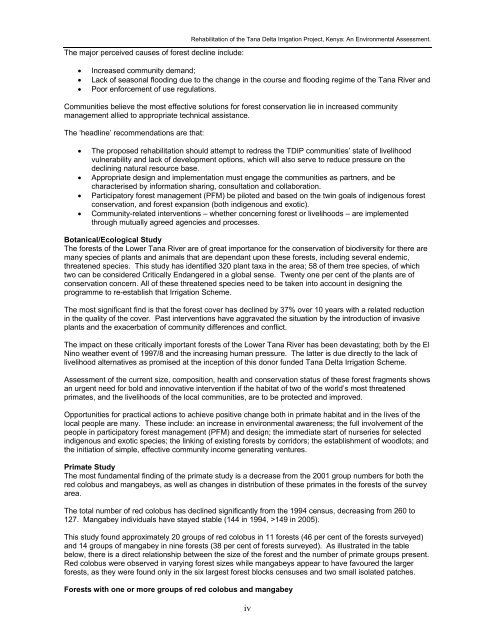Tana Delta Irrigation Project, Kenya: An Environmental Assessment
Tana Delta Irrigation Project, Kenya: An Environmental Assessment
Tana Delta Irrigation Project, Kenya: An Environmental Assessment
You also want an ePaper? Increase the reach of your titles
YUMPU automatically turns print PDFs into web optimized ePapers that Google loves.
The major perceived causes of forest decline include:<br />
Rehabilitation of the <strong>Tana</strong> <strong>Delta</strong> <strong>Irrigation</strong> <strong>Project</strong>, <strong>Kenya</strong>: <strong>An</strong> <strong>Environmental</strong> <strong>Assessment</strong>.<br />
• Increased community demand;<br />
• Lack of seasonal flooding due to the change in the course and flooding regime of the <strong>Tana</strong> River and<br />
• Poor enforcement of use regulations.<br />
Communities believe the most effective solutions for forest conservation lie in increased community<br />
management allied to appropriate technical assistance.<br />
The ‘headline’ recommendations are that:<br />
• The proposed rehabilitation should attempt to redress the TDIP communities’ state of livelihood<br />
vulnerability and lack of development options, which will also serve to reduce pressure on the<br />
declining natural resource base.<br />
• Appropriate design and implementation must engage the communities as partners, and be<br />
characterised by information sharing, consultation and collaboration.<br />
• Participatory forest management (PFM) be piloted and based on the twin goals of indigenous forest<br />
conservation, and forest expansion (both indigenous and exotic).<br />
• Community-related interventions – whether concerning forest or livelihoods – are implemented<br />
through mutually agreed agencies and processes.<br />
Botanical/Ecological Study<br />
The forests of the Lower <strong>Tana</strong> River are of great importance for the conservation of biodiversity for there are<br />
many species of plants and animals that are dependant upon these forests, including several endemic,<br />
threatened species. This study has identified 320 plant taxa in the area; 58 of them tree species, of which<br />
two can be considered Critically Endangered in a global sense. Twenty one per cent of the plants are of<br />
conservation concern. All of these threatened species need to be taken into account in designing the<br />
programme to re-establish that <strong>Irrigation</strong> Scheme.<br />
The most significant find is that the forest cover has declined by 37% over 10 years with a related reduction<br />
in the quality of the cover. Past interventions have aggravated the situation by the introduction of invasive<br />
plants and the exacerbation of community differences and conflict.<br />
The impact on these critically important forests of the Lower <strong>Tana</strong> River has been devastating; both by the El<br />
Nino weather event of 1997/8 and the increasing human pressure. The latter is due directly to the lack of<br />
livelihood alternatives as promised at the inception of this donor funded <strong>Tana</strong> <strong>Delta</strong> <strong>Irrigation</strong> Scheme.<br />
<strong>Assessment</strong> of the current size, composition, health and conservation status of these forest fragments shows<br />
an urgent need for bold and innovative intervention if the habitat of two of the world’s most threatened<br />
primates, and the livelihoods of the local communities, are to be protected and improved.<br />
Opportunities for practical actions to achieve positive change both in primate habitat and in the lives of the<br />
local people are many. These include: an increase in environmental awareness; the full involvement of the<br />
people in participatory forest management (PFM) and design; the immediate start of nurseries for selected<br />
indigenous and exotic species; the linking of existing forests by corridors; the establishment of woodlots; and<br />
the initiation of simple, effective community income generating ventures.<br />
Primate Study<br />
The most fundamental finding of the primate study is a decrease from the 2001 group numbers for both the<br />
red colobus and mangabeys, as well as changes in distribution of these primates in the forests of the survey<br />
area.<br />
The total number of red colobus has declined significantly from the 1994 census, decreasing from 260 to<br />
127. Mangabey individuals have stayed stable (144 in 1994, >149 in 2005).<br />
This study found approximately 20 groups of red colobus in 11 forests (46 per cent of the forests surveyed)<br />
and 14 groups of mangabey in nine forests (38 per cent of forests surveyed). As illustrated in the table<br />
below, there is a direct relationship between the size of the forest and the number of primate groups present.<br />
Red colobus were observed in varying forest sizes while mangabeys appear to have favoured the larger<br />
forests, as they were found only in the six largest forest blocks censuses and two small isolated patches.<br />
Forests with one or more groups of red colobus and mangabey<br />
iv

















